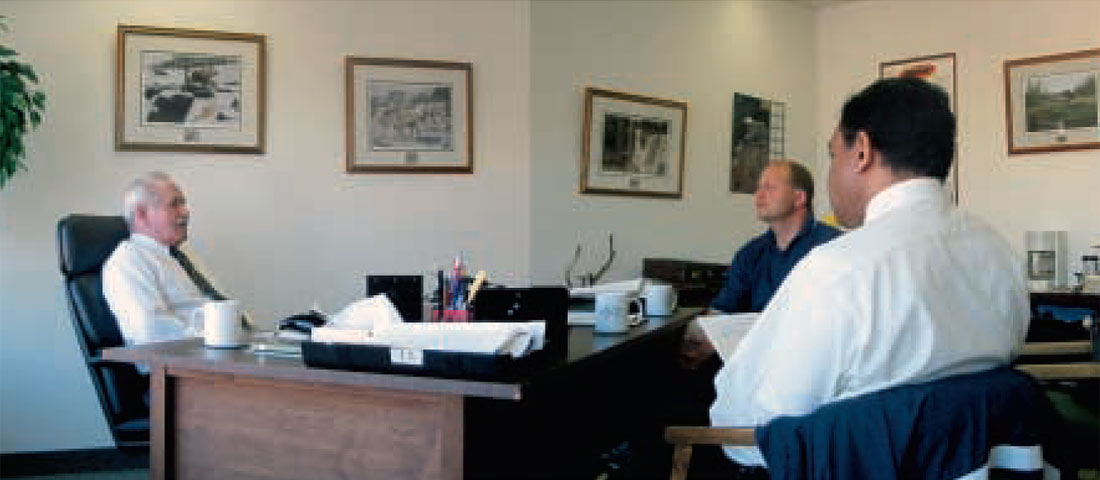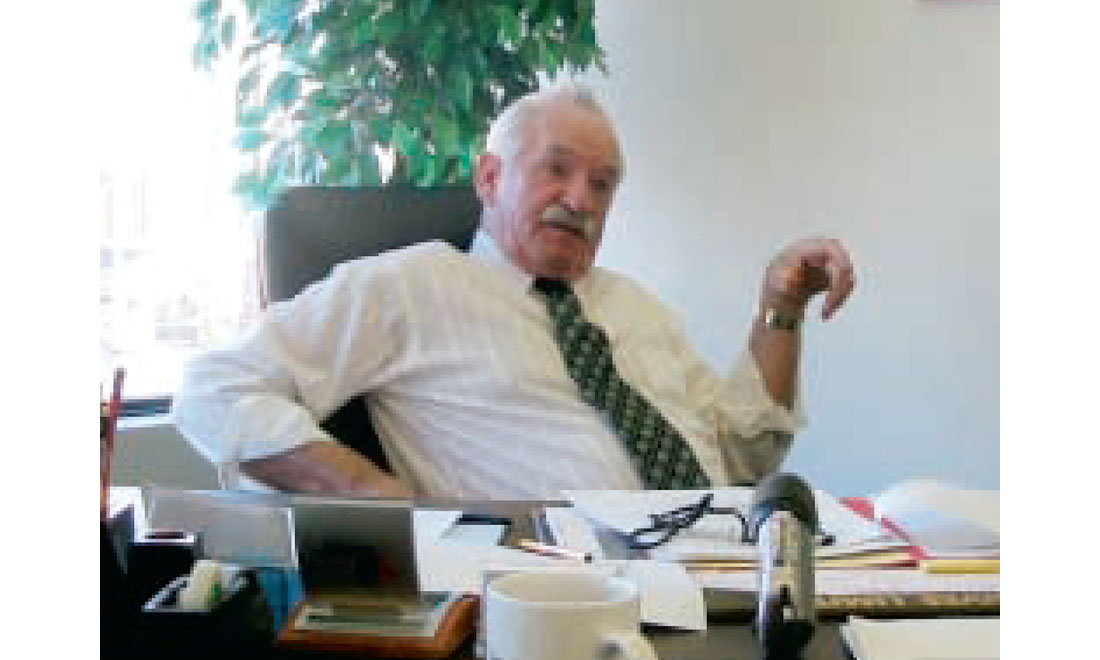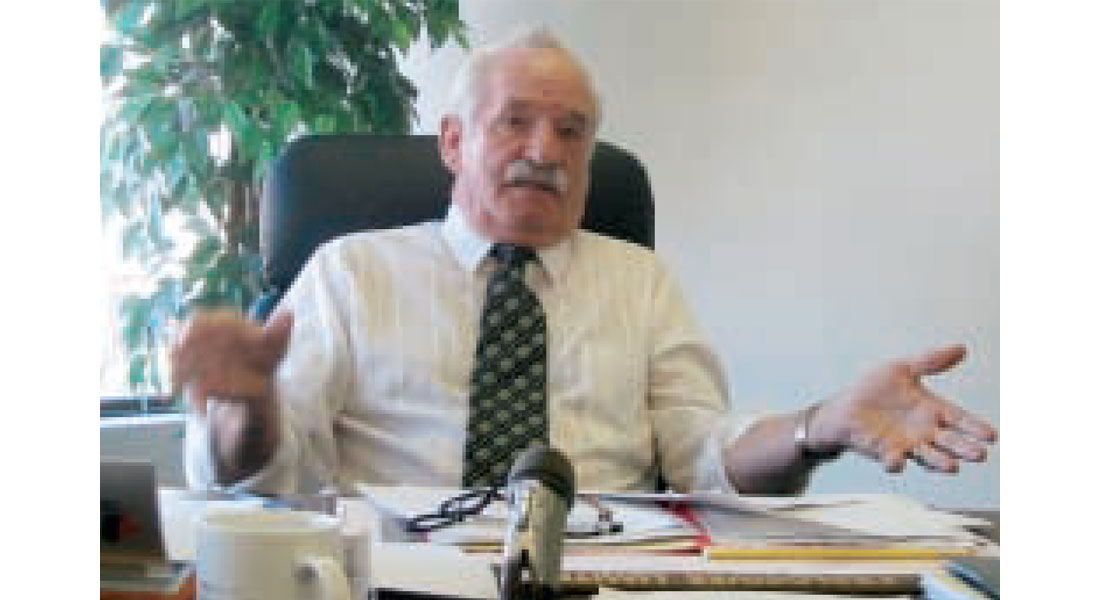
The Recorder editors recently had the chance to visit CAGC President Bill Kammermeyer. With Bill nearing retirement, it was a great opportunity to look back on a successful career that was a big part of Alberta’s geophysical field acquisition industry since the 1950’s. The following are excerpts from the interview with this most gracious man.
[Satinder]: Bill, tell about us your early education and experience.
I was born in Humboldt, Saskatchewan. In 1933 I entered grade I in Humboldt. The family moved to St. Catherine’s, Ontario during the war years where I completed grades III to VI. In 1945, after the war, we moved back to Saskatoon, Saskatchewan, where I graduated with a grade XII diploma from Nutana Collegiate in 1950.
[Oliver]: When you graduated from high school was it common for young men to go into the oil industry, as rig hands?
I won’t say it was common, however there were very good job opportunities in the oil patch. In 1951 I landed in Leduc looking for a job as a roughneck. Because I had no experience it took me quite a while to find employment. I worked as a roughneck and a derrick hand for 3 years in Leduc, Devon, Calmar, Stettler, Coronation, and Drayton Valley. I was hurt in a rig accident in January of 1954. I spent 3 months, (February to April) in the Misicordia Hospital and the Workers Compensation Board’s Rehabilitation Clinic in Edmonton.
[Oliver]: How did the accident happen?
I was changing burned out light bulbs on the derrick. It was a cold night, 54 degrees below zero, I remember that real well. There was a lot of hoar frost on the derrick and I slipped and fell.
[Oliver]: Would you say that safety standards have improved since then?
You bet. No doubt in my mind. Safety has improved immensely on the rigs. Don’t get me wrong. We were quite safety conscious in those days as well. However there are more safety requirements to follow now than in those days. I have not worked on the rigs since 1954 but I’ve been to Nisku where the Petroleum Industry Training Service (PITS) now trains Roughnecks and Derrick hands. There were no such training facilities when I started working in the oil patch - you learned on the job. I believe today a person will not be hired to work on a rig without first taking and passing the training course offered by P.I.T.S.
[Satinder]: Didn’t the accident discourage you from continuing in the same line of work?
I broke my right heel and ankle, and found out after my rehabilitation was completed that I could not work as a rig hand any longer. Since my career as an oilman came to an abrupt end, I applied for a job with the Alberta Government as a Technical Office Assistant with the Department of Lands and Forest. As their office assistant, I became Forestry’s first aerial photography librarian.
[Satinder]: So you worked for Lands and Forests Planning Branch. Did it entail any fieldwork like surveying?
As I stated before, I started out with Forestry as an office assistant. I did not find this position to be challenging enough. I felt my next step up with the Branch would be to become a Photogrammetrist. In order to qualify for a Photogrammetrist position I spent the summer cruising timber in the Peace River and Grand Prairie forests to obtain the necessary experience. In 1955 I applied for and was successful in obtaining a Photogrammetrist position - interpreting from aerial photographs timber stands, distinguishing them by species, height and density; this data was used in producing timber type maps for timber sale purposes.

In 1957 I resigned my position with the Government to become a Foreman at Smiths Chicken Hatchery in Edmonton. After the Hatching season the owner of the Hatchery and I decided to raise 5,000 turkeys on a farm he owned near Goose Lake. It did not take long for me to realize this was not the job for me and I returned to the Alberta Government, filling the same Photogrammetrist position that I had vacated 3 months previously.
In 1965 I was promoted to the Geophysical Coordinator position with the Forest Surveys and Planning Branch. My duties were to review for approval or rejection purposes all seismic exploration programs applied for by industry to be conducted in the forested area of Alberta (green area).
[Satinder]: What were the criteria followed for approval or rejection of exploration programs? Anything to do with our environment?
Oh, yes definitely, environmental impact was a crucial part of the review process. Program plans were plotted on forestry cover maps to determine the types of timber etc. that the proposed cut lines would be affecting. As well, cut lines would not be approved if they were located too close to creeks. Types of creek crossings were also considered; snow fills, fording, and Native log bridges etc. Yes, there were a lot of environmental concerns to evaluate when reviewing an exploration program for approval purposes.
[Oliver]: Would the main reason for not constructing a seismic line too close to a creek be that this activity would cause erosion?
Yes, basically seismic lines should never parallel creeks too closely and creeks should always be crossed at right angles, to minimize creek bed disturbances. In the winter months industry would be directed to construct dirt free snow and ice creek crossings, or lay logs across the creek from bank to bank if the distance between the creek banks was narrow enough. These are the types of conditions of approval that were put in a letter authorizing a program to be conducted.
[Oliver]: Have you seen large changes, improvements in the environmental standards over the years?
For sure! Today, proposed preliminary program plans are submitted to forestry field offices; forest officers who are familiar with the terrain identify activity that can be conducted in regions considered environmentally sensitive. Forest officers determine the condition of approval under which a program is authorized. They e-mail their conditions to head office in Edmonton. These conditions are put in the letter of approval that is forwarded to the company that made the exploration program application. There are now many more environmental conditions attached to program approvals.
[Oliver]: Now that you are nearing retirement, is it a feeling of satisfaction that it has progressed to this point?
Definitely. I’m happy to see that the Provincial Government takes environmental issues and concerns seriously and applies them religiously to programs.
[Satinder]: In 1974 you took over the position of Chairman of the Exploration Review committee under the Land Conservation Regulation.
Yes. This committee reviewed for approval and/or rejection purposes all coal exploration programs. Committee members determined the conditions of approval under which a coal exploration program could be conducted. I chaired this committee from 1974 to December 1981.
[Satinder]: Going back to January 1982, could you tell us about the West Pembina Reclamation Project?
The West Pembina oil field was probably the most active area since the Rainbow Zama Lake days. Numerous oil companies carried out many exploration programs in this region, resulting in unacceptable damages to the environment. Forestry personnel could not identify the individual oil company responsible for any specific damages because numerous companies shot the same seismic lines over and over in that time period. Government informed industry that since the individual companies responsible for the environmental damages could not be identified, all oil companies involved in conducting exploration programs in the West Pembina region were being held jointly responsible for the required reclamation work. To accommodate Government’s direction, all oil companies involved formed a group called The West Pembina Consortium.
The consortium required someone to coordinate the activities of the companies involved in the reclamation and restoration of the West Pembina area. Since I had many years of Government service, and knew what the Government’s environmental issues of concern were (i.e.,) erosion controls, flowing holes, proper creek crossings, slashing standards etc., I applied for and was successful in obtaining the Consortium Coordinator Position.
[Satinder]: In 1981 you resigned from a government job after over 27 years of service. Why did you resign after so many years of service?
Well, when the Director of the Exploration Review Branch resigned, I thought that was my next step career wise. When I questioned the Assistant Deputy Minister if I was being considered to fill the position I was informed that since I did not have a university degree in Geophysics I could not be a candidate for the Director position. I was informed I would remain Manager of Geophysical Coordination with the Exploration Review Branch.
It was at this precise time that I heard that the Canadian Association of Geophysical Contractors was looking for a replacement for their business manager. In January of 1982 I assumed the position of General Manager for the CAGC.
[Oliver]: So you have been here since?
Yes, that’s right.
[Oliver]: Twenty years, that’s just like a second career.
Yes, I certainly do consider it a second career and I feel privileged to have been able to do so.
[Oliver]: I would say that generally our readers in the CSEG don’t know that much about the CAGC. Would you go over the role of the CAGC?
The CAGC looks after the needs of its members. We have 6 different Active membership categories. There’s the Prime Contractors, companies that actually go to the field and collect geophysical data. Then we have Seismic Drillers, Seismic Surveyors, Cat/Slashing Contractors, Service and Supply companies, Consultants and Front End companies. We have 11 Directors on the board. Six Directors represent the Prime Contractors and each new membership category has a director serving on the board that looks after the wants and needs of that particular category. I guess my job, as President, is to keep things flowing and to coordinate the association’s activities. The way it’s turned out, I’m President, Treasurer, and the General Manager, all rolled into one. So it keeps me fairly busy.
[Oliver]: I suppose you rely on the 11 directors quite a bit.
For sure I do. The Directors and Chairman of the CAGC do the majority of the work that has to be done outside of this office. They tell me what needs to be done in a particular area of concern and I do whatever is necessary to make sure it is carried out.
[Satinder]: Why have you decided to resign from this post now?
I’m now 69 - I’m getting up there! I’ll be 70 years old in March of 2003. I think it’s time for new blood to take over.
[Satinder]: So you think you have crossed your bridges and now deserve to enjoy the fruits of your labor?
Yes. I can leave this position feeling good in what I have been able to accomplish, knowing full well this association will in the future provide more and better services for the members. It will be the backbone of a strong exploration industry.
[Satinder]: Bill you have been through a long journey. Could you tell us about some memorable experiences in your professional life?
One real memorable experience that comes to mind was when the CAGC executive considered disbanding the CAGC to join the Petroleum Services Association of Canada (PSAC). At the time there were only 6 Directors on the CAGC Executive; as well the only members of the CAGC who had a vote were the Prime Contractors. They had total control over the directions the CAGC would take. The responsibilities of the Directorship fell on about 10 active members of the association. 6 of the 10 members were expected to carry the ball year after year. I think they got a little tired, so they entertained the idea of joining the PSAC. At that time I did not see this move to be very beneficial to the membership. I was convinced the members would benefit a lot more by retaining the CAGC as their association.

The members had 3 alternatives. We considered joining the IAGC (International Association of Geophysical Contractors) as a Canadian Chapter, or change the CAGC bylaws to expand our active membership category to include all Associate members (with the exception of oil companies) as active members with voting privileges, or disband the CAGC and join PSAC. To me, that was a very stressful time. I was relieved when the membership voted to keep the association intact by increasing the active membership category to include previously considered associate members as active members. By increasing the number of Directors from 6 to 11 the CAGC tapped into a wealth of experience that in the past had not been utilized. This event sticks out in my memory as an accomplishment I am very proud and happy to have been a part of.
[Oliver]: How do the various industry ups and downs affect the CACG, like the downturn in 1986?
It affects the memberships drastically, especially the Prime Contractors, because if their contracts aren’t there, they and their sub-contractors remain unemployed. A number of Primes close their doors if the work isn’t there. Supply and demand comes into play. You might have 30 Prime Contractors and the market only requires 20. Today we only have 19 Prime Contractors and even now it’s a tough sell to keep busy. We could be a lot busier than we are - I am sure our members would like to see busier times. Unfortunately, we have had a number of mediocre years lately. What I would like to see is a good season for a change where all Prime Contractors and Sub Contractors are busy. That would be, in my opinion, a real boost to the Geophysical industry.
[Oliver]: Does the CAGC coordinate and interact quite a bit with APEGGA?
No, we interact mostly with the Canadian Association of Petroleum Producers (CAPP). As a matter of fact we just met with the President and Office Manager of the CSEG. We are attempting to identify synergies that may benefit both associations. I would say we now interact with both associations, CSEG and CAPP.
[Oliver]: From Satinder’s and my point of view a lot of members of the CSEG are also members of the CAGC and I think we could probably print material from your association so that our members know what is going on, maybe even on a monthly basis.
Yes, I’m hoping we become much closer than we have in the past. I believe it’s time the CAGC branches out and becomes involved with more industry related associations.
[Oliver]: I think the majority of our members work for oil companies and they are also the users of the services provided with CAGC Contractors, so they should be aware of what is going on.
[Satinder]: Let me ask you a very general question. Based on your experience, what would be your message for the younger generation?
I would say it doesn’t matter what profession or occupation you attempt, always put your best foot forward. Your rewards will be directly proportional to the effort you make. If the younger generation takes their responsibilities seriously and give a little more than is expected, they will be successful.
[Oliver]: Speaking of the younger generation are these children in the pictures on your desk your grandchildren?
Yes, those are some of them. I had seven children; six sons and one daughter. They are all married now, and of course they have their own children. I now have 15 grandchildren.
[Oliver]: What are you looking forward to in your retirement?
I have a quarter section of land about 50 miles Northeast of Edmonton near a thriving town called Redwater. Redwater is an old oil field with very shallow oil wells. I bought a quarter section out there in 1968. My wife passed away in 1997. What we planned on doing was retiring there to raise a few head of cattle – I’ll do it yet! I’ll raise a few head of cattle on that quarter section in the summer months, sell them when the snow flies and in the winter months become a snowbird in Palm Springs, California.
[Oliver]: I thought you were going to say you were planning to raise turkeys out there!
Not a chance. (Laughter) Oh, what an awful experience that was. (Laughter)
[Satinder]: Bill thank you very much for sharing your time with us.
You’re welcome. This interview was not as painful as I thought it would be.
[Oliver]: Like an interrogation? (Laughter)
It was my pleasure.











Share This Interview